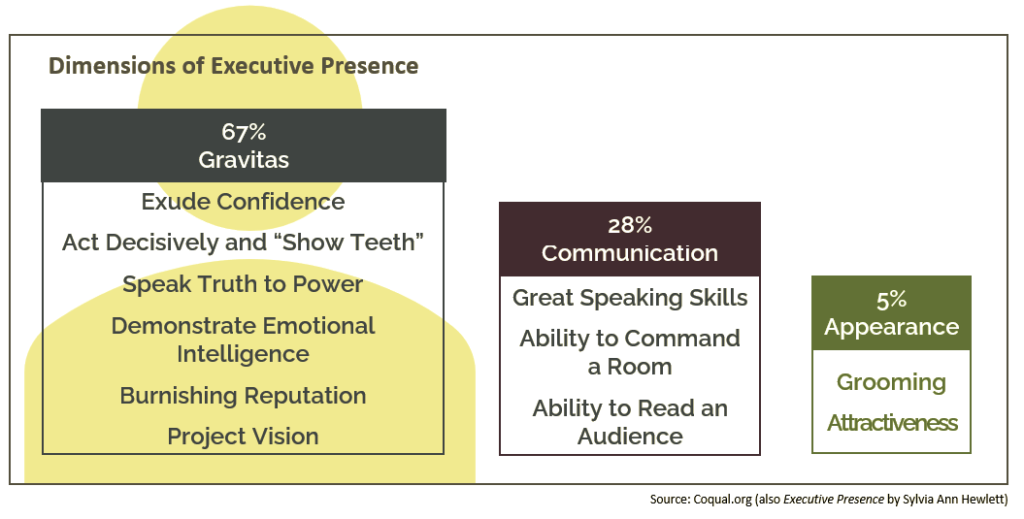Engage your team, hold their attention, retain your talent, inspire your company, be yourself
Executive presence is that elusive quality that you recognize when you see it, but cannot quite pin down to a formula to copy. It is a quality most experienced leaders desire, and emerging leaders want to develop.
A compelling leadership presence will help you build trust, credibility and followership.
Executive presence is made up of several qualities and skills – it’s the ability to take command of a room, assume a leadership role in various scenarios and circumstances, share your thoughts with confidence, present grace under pressure, and strike a balance between talking and listening such that your communication style is engaging, persuasive and impactful.
Coqual conducted a 2012 study that included surveys college-graduate professionals, and one-on-one interviews with high-level executives. They concluded that Executive Presence is viewed as having three universal dimensions: gravitas, communication, and appearance.
A further study of executives concluded that “gravitas” is the most important characteristic of Executive Presence. The group contributes 67% toward one’s Executive Presence, while communication contributes 28% and appearance rounds us out at 5%.
“Coqual’s Founder (and author of the book “Executive Presence”) Sylvia Ann Hewlett states clearly that Executive Presence “is not a measure of performance… it’s a measure of image.” And yet, Executive Presence constitutes 26 percent of what senior leaders say it takes to get the next promotion”. (Your executive presence needs a second look – Recover to Lead)

Gravitas, being the most influential quality in carrying a compelling leadership presence has some very hard words in it – “Show teeth”, Burnishing reputation (burnish = to give something a smooth shiny look), exude confidence. In developing these attributes, it is important to acknowledge that the model is based on North-American, white leaders, predominantly male.
The six attributes listed in gravitas are foundational to good leadership, however we reserve the right to adjust the adjectives to match the organizational or contextual culture of the organization, and ethnic culture with which the leader identifies as an individual.
Executive presence should become the representation of yourself in a professional setting, achieving confidence, decision-making capacity, truthfulness, emotional intelligence, good reputation, and shared vision. Communication skills are crucial, it is your only music instrument in the symphony of leadership. I would personally rate it much higher than 28%.
Appearance – you have to look like you have some pride, in yourself, and way you carry yourself.
The benefit of the study and the book is that it defines the elusive concept. In a post-Covid world where we all reconnected with our humanity, it needs to held loosely to accommodate your authenticity. Executives still need presence, the formula is probably less clear than it was before, and should leave space for a unique contextually appropriate interpretation of the concept.
How will you know it is working for you?
- Ask for feedback from trusted peers and mentors.
- Ask your coach to observe your “presence” in a room with your team.
- Do you feel you are getting positive results from your interactions with others?

